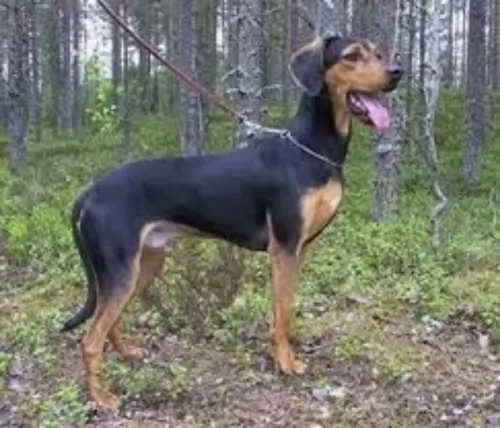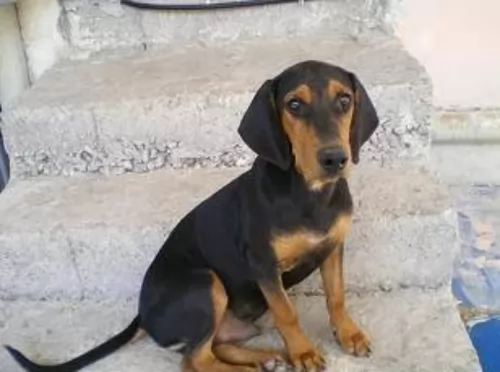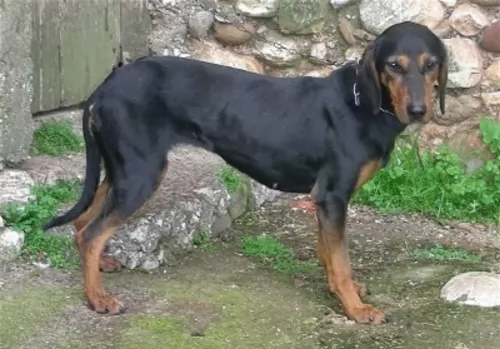 Petzlover
Petzlover Greek Harehound is originated from Greece but Scottish Deerhound is originated from United Kingdom. Greek Harehound may grow 26 cm / 10 inches shorter than Scottish Deerhound. Greek Harehound may weigh 30 kg / 66 pounds lesser than Scottish Deerhound. Greek Harehound may live 3 years more than Scottish Deerhound. Greek Harehound may have less litter size than Scottish Deerhound. Both Greek Harehound and Scottish Deerhound requires Low Maintenance.
Greek Harehound is originated from Greece but Scottish Deerhound is originated from United Kingdom. Greek Harehound may grow 26 cm / 10 inches shorter than Scottish Deerhound. Greek Harehound may weigh 30 kg / 66 pounds lesser than Scottish Deerhound. Greek Harehound may live 3 years more than Scottish Deerhound. Greek Harehound may have less litter size than Scottish Deerhound. Both Greek Harehound and Scottish Deerhound requires Low Maintenance.
 Known also as the Hellenic Hound, the Greek Harehound is an ancient breed, and it is a dog which has come down through the ages with very little change to the way he looks.
Known also as the Hellenic Hound, the Greek Harehound is an ancient breed, and it is a dog which has come down through the ages with very little change to the way he looks.
The ancestors of the Greek Harehound go back thousands of years and are believed to be the ancient ‘Laconikoi’ dogs of the Peloponnese.
In was in 1996 that the Federation Cynologique Internationale recognized the Hellenic Hound. The Greek Harehound was also recognized by the United Kennel Club (UKC) in 2006.
 The Scottish Deerhound is considered the Royal Dog of Scotland. It is a sighthound that is large and bred to hunt large Red Deer. They are similar in appearance to the Greyhound, but they are bigger and heavier. Closely related to the Irish Wolfhound, they were used in creating it. The Scottish Deerhound is an ancient breed that is now very rare. It can trace its lineage to the 16th and 17th centuries.
The Scottish Deerhound is considered the Royal Dog of Scotland. It is a sighthound that is large and bred to hunt large Red Deer. They are similar in appearance to the Greyhound, but they are bigger and heavier. Closely related to the Irish Wolfhound, they were used in creating it. The Scottish Deerhound is an ancient breed that is now very rare. It can trace its lineage to the 16th and 17th centuries.
The Deerhound was a favorite of hunting nobility and could not be kept by any person or household that did not have at least the rank of earl. Despite this history the Scottish Deerhound was not considered separate from the Highland Greyhound and other staghounds until the 19th century. They were bred to stalk or “course” the red deer and were used extensively for this purpose until the beginning of the 20th century. At that time there was a need for smaller, slower deer tracking dogs.
At the start of the 20th century, the land for deer hunting had grown smaller and so had the deer. Also, the invention of the rifle made the fast Deerhounds who could cover large tracks of ground in minutes, no longer a necessity for successful hunting. As the clan systems fell and the nobility rose, the Deerhounds became the dog for nobility and landowners. There were a few non-nobilities who also kept them and hunted with them. As they were less needed for hunting a few households kept them as show dogs.
In the United States and Canada, both the Scottish Deerhound and the Greyhound were used for hunting wolves and deer. In Australia, the Kangaroo Dog – a deerhound crossbreed, and Deerhounds were used to hunt wild boar, emu and kangaroos. The Deerhound is one of the oldest of the breeds that are Greyhound-like. The Deerhound is not as fast as the Greyhound if they are running on a smooth surface. Get them on a rough surface and the will out that Greyhound. They appear to be larger and rougher than they really are. This gives them an advantage over the lighter, smaller Greyhound.
The Deerhound was a contributor to development of the Irish Wolfhound toward the end of the 19th century.
 These dogs have a short, dense coat which is black and tan in color. He is a medium sized, well proportioned, deep chested dog standing at roughly 47 – 55cm in height and weighing between 17–20kg.
These dogs have a short, dense coat which is black and tan in color. He is a medium sized, well proportioned, deep chested dog standing at roughly 47 – 55cm in height and weighing between 17–20kg.
His legs are straight, well boned and strong. The skull of the dog is fairly flat, the eyes are brown while the ears are set high and are floppy. The tail is long, tapering down to a tip.
Lively and outgoing, the Greek Harehound is a skilled, brave hunter. These are active dogs and will require quite a bit of exercise if you get one as a pet. He becomes devoted to his owner, making a good, all-round family pet.
He has always been used in the past to hunt in packs so he gets on well with any other dogs in the family.
As a scenthound, the Greek Harehound is an independent, stubborn, strong-willed dog that will respond well to a firm, strong owner. His stubborn, strong-willed nature means it will be important to have him trained and socialized so that he becomes a well-rounded, obedient pet.
If you're looking for a true around-the-house family pet, this isn't the ideal choice as he is essentially a hunting dog, wanting to be running off on a hunt as opposed to lying quietly indoors. He is therefore better suited to life in the country than being cooped up in a small city property.
 The Scottish Deerhound looks a lot like the Greyhound, except it is heavily boned and larger in size. The Deerhound is also different in several other ways. Instead of the Greyhound, the Scottish Deerhound is more closely related to the Irish Wolfhound than the Deerhound. The Deerhound is a large, rough coated breed. It is a very tall breed; in fact, it is the tallest of all sighthounds.
The Scottish Deerhound looks a lot like the Greyhound, except it is heavily boned and larger in size. The Deerhound is also different in several other ways. Instead of the Greyhound, the Scottish Deerhound is more closely related to the Irish Wolfhound than the Deerhound. The Deerhound is a large, rough coated breed. It is a very tall breed; in fact, it is the tallest of all sighthounds.
The Deerhound has a long head with a flat skull and a muzzle that tapers at the end. They have dark eyes and a scissor bite with a tail that can be either curved or straight. The hair on their tails almost touches the ground. The rest of its coat is wiry and harsh with a beard, mustache and mane. The ears are soft and can be either held semi erect or folded against their head. Their coat is gray or grey-blue today but in the past, it might have been brindle, red fawn or yellow.
 Fast, courageous, smart, playful, independent and strong willed, the Greek Harehound is a slow maturing breed and he will require training and socialization to make him obedient and not so stubborn.
Fast, courageous, smart, playful, independent and strong willed, the Greek Harehound is a slow maturing breed and he will require training and socialization to make him obedient and not so stubborn.
Once trained he becomes a truly wonderful companion, being affectionate, loyal and outgoing. He makes a good friend of children too.
He is friendly and non-aggressive, though he still makes a good watchdog. He is a low maintenance pet too, and even though he is essentially a hunting dog, he can make anyone a splendid pet.
 The Greek Harehound is a healthy dog breed with no particular genetic defects. But like other dogs with floppy ears, they are more prone to infections and the insides of the ears will need to be cleaned frequently. Always do this with the utmost care to avoid damaging your pet's ears.
The Greek Harehound is a healthy dog breed with no particular genetic defects. But like other dogs with floppy ears, they are more prone to infections and the insides of the ears will need to be cleaned frequently. Always do this with the utmost care to avoid damaging your pet's ears.
He is a deep chested dog and this puts him at risk of gastric dilation and volvulus which is commonly referred to as bloat. Its a life threatening health issue where the stomach can twist. The stomach is sealed off as a result and gas builds up. The dog can go into organ failure.
 The Scottish Deerhound does face some serious challenges on the health front. These include:
The Scottish Deerhound does face some serious challenges on the health front. These include:
• Cystinuria – recessive disorder that causes an inability for cystine to be filtered from the urine.
• Gastric Dilatation Volvulus – otherwise known as bloat and it can be life threatening if not treated quickly.
 The Greek Harehound is happiest when he senses he is free to follow scents and run. This is why this particular dog breed isn’t suited for life in the city where he has a small garden. He requires large pieces of ground to run free. If you own one of these dogs, he should be taken on daily walks and be involved in lots of sporting activities and games. If you’re a jogger or cyclist, this dog will be thrilled to join you.
The Greek Harehound is happiest when he senses he is free to follow scents and run. This is why this particular dog breed isn’t suited for life in the city where he has a small garden. He requires large pieces of ground to run free. If you own one of these dogs, he should be taken on daily walks and be involved in lots of sporting activities and games. If you’re a jogger or cyclist, this dog will be thrilled to join you.
Dog owners love that this dog is a low maintenance breed. The short coat simply requires a brush twice a week to rid him of loose hairs and to also keep his coat shiny and healthy.
Every new puppy will require a series of vaccinations in his first year to make sure he doesn't develop some of the serious dog diseases there are such as distemper, parvo-virus and rabies among others.
Dogs are carnivores and without human interference have always eaten fresh meat in the wilds. For convenience many people feed their dogs commercially manufactured food.
There are some excellent brands. Choose the best one for your pet and mix in raw meat from time to time as well as cooked rice, chicken and vegetables.
Never leave your pet without a constant supply of fresh, cool water.
 1.Feeding the puppy – Feed a high quality large or x large puppy dogfood at least 3-4 times a day. Do not overfeed.
1.Feeding the puppy – Feed a high quality large or x large puppy dogfood at least 3-4 times a day. Do not overfeed.
2.Feeding the adult – Feed a high-quality adult large or x large dog food once or twice a day. Do not overfeed.
4. Games and Exercises – The Deerhound needs plenty of exercise in a safe place where they have plenty of room to run. A small yard or life on a leash are not enough for this energetic breed. Play fetch, course running, Like the Greyhound they will be couch potatoes if you let them but that will hurt their health. Lure Coursing or hare coursing are good. Coyote hunting. Find space where they can run for the joy of running. Never force them to run – like along a bicycle